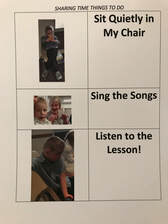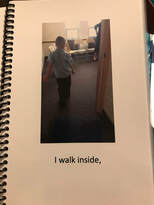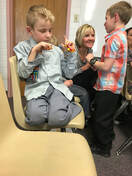|
"Charity suffereth long, and is kind; charity envieth not; charity vaunteth not itself, is not puffed up, Doth not behave itself unseemly, seeketh not her own, is not easily provoked..."
1 Cornithians 13: 4-5 |
Behavior Management Tips
Think How the Savior Would View Them:
Think how the Savior would view them. Have charity towards each individual. Allow them to change. Each week is a new week. Talk to them like they are going to do well each week. Be firm, but kind. Playfulness and acceptance go a long way.
Think how the Savior would view them. Have charity towards each individual. Allow them to change. Each week is a new week. Talk to them like they are going to do well each week. Be firm, but kind. Playfulness and acceptance go a long way.
*Consult with parents on what is already being done. It is important to hear them out and involve them on what they feel is appropriate for their child. They know their child best.

Schedules and Rules:
Schedules allow individuals to know the expectations and anticipate what will happen next. You can use object, picture, or word schedules (See pdf at the bottom for links). You can also display basic rules and expectations in a similar way. Using pictures of the student doing the actions and steps, can help them personalize and internalize the schedule and rules.
Rules should be written in a positive way, such as "hands to yourself" instead of "don't hit others." Having clear natural consequences is also ideal. (Avoid threats and punishments)
Explain the rules and schedule to the child and give the why. Explain the consequences.
Schedules allow individuals to know the expectations and anticipate what will happen next. You can use object, picture, or word schedules (See pdf at the bottom for links). You can also display basic rules and expectations in a similar way. Using pictures of the student doing the actions and steps, can help them personalize and internalize the schedule and rules.
Rules should be written in a positive way, such as "hands to yourself" instead of "don't hit others." Having clear natural consequences is also ideal. (Avoid threats and punishments)
Explain the rules and schedule to the child and give the why. Explain the consequences.

Social Stories:
Social stories help a student learn expectations in a story form. Using photos of a student are ideal. Each page should have a phrase or sentence. Social stories tell what the individual should do, what happens, how people are pleased with their decision and conclude it is a good idea. These can be read before or at the start of class, to lay down the expectations or as a reminder. You can learn more about writing social stories here. |
Expectations:
Look at the individual's behavior compared to themselves. This way you can allow them to be more apart of the group and not feel horrible about themselves with unrealistic expectations. For example, some students impulsively talk or make sounds. Expecting them to be completely quiet before they have a turn would be unrealistic. Have high expectations...look for improvement. If you see behaviors getting worse and the individual exerts more and more control of the environment, this can be a sign that expectations are too low and higher expectations will likely help. When you implement a bit more boundaries, it is typical for them to resist, but usually they will get better if you stick to it. Make sure you follow through with consequences and rules. This can be positive, loving and firm.
Look at the individual's behavior compared to themselves. This way you can allow them to be more apart of the group and not feel horrible about themselves with unrealistic expectations. For example, some students impulsively talk or make sounds. Expecting them to be completely quiet before they have a turn would be unrealistic. Have high expectations...look for improvement. If you see behaviors getting worse and the individual exerts more and more control of the environment, this can be a sign that expectations are too low and higher expectations will likely help. When you implement a bit more boundaries, it is typical for them to resist, but usually they will get better if you stick to it. Make sure you follow through with consequences and rules. This can be positive, loving and firm.
Positive Reinforcement:
Catch the individual doing things right and give sincere complements. In some cases other tangible items the child enjoys can also help.
Catch the individual doing things right and give sincere complements. In some cases other tangible items the child enjoys can also help.
Keep Attention with Performing:
Sometimes quietly asking them questions throughout the class can help them focus and be busy, so they don't have time to get into trouble. While a peer is answering a question, give them choices for them to answer the same question or tell you what their peer said.
Sometimes quietly asking them questions throughout the class can help them focus and be busy, so they don't have time to get into trouble. While a peer is answering a question, give them choices for them to answer the same question or tell you what their peer said.
|
Teaching How to Sit:
Lack of sitting is not always a negative behavior. The struggle to sit goes back to their sensory systems and the expectation that they are truly a part of the group even if they are 'different.' Some students need to stand to learn their best. An individual like this can be taught how to stand or hop around in a particular area. Their peers get use to them and learn to focus. (Sometimes all can stand.) Many can learn to sit. This can be done respectfully and with understanding. The video to the right gives suggestions and visual modeling. |
|
Noises:
Sometimes individuals make repeated noises over and over or say phrases. Often their peers will get use to it. However, everyone can improve. Ideas: remind them they are making noises and ask them to see if they can do it quieter so others can listen, hand them something to do with their mouth instead of make noise, sometimes (with permission) you can tap around their mouth to help desensitize it, other can be taught to be quiet using reinforcement.
Give Choices:
Where possible, give choices. This helps the child have appropriate control of their life that is often controlled by others due to their need for extra care and supervision.
Where possible, give choices. This helps the child have appropriate control of their life that is often controlled by others due to their need for extra care and supervision.
|
|
Peer Interaction: Peer interaction can be a critical ingredient in helping an individual manage themselves in church most effectively. (See the video for more understanding.) |
Prevention/Replacement Behavior:
Ideally prevent behaviors before they happen. If you can figure out the triggers strive to implement strategies before the behavior happens. Try to find something for the individual to do that performs the same function for the child.
Ideally prevent behaviors before they happen. If you can figure out the triggers strive to implement strategies before the behavior happens. Try to find something for the individual to do that performs the same function for the child.
Desensitization:
Sometimes you will slowly need to help them get use to being with groups. Spend a bit of time with the group, then give a break. The break can be structured but just to give sensory relief from an overload sensory system.
Sometimes you will slowly need to help them get use to being with groups. Spend a bit of time with the group, then give a break. The break can be structured but just to give sensory relief from an overload sensory system.
During Behaviors:
If the individual is 'having a behavior' do not give undo attention to it. Give instructions on what to do instead of using words like 'stop,' For example, instead of "stop hitting" say "put your hands in your lap" or "come sit with me." Discuss with parents any expectations needed.
Tantrums:
There are many reasons and causes for tantrums. This is a link to possible reasons for tantrums and ideas of how to help manage tantrums in a positive way.
See here, here and here for more ideas.
If the individual is 'having a behavior' do not give undo attention to it. Give instructions on what to do instead of using words like 'stop,' For example, instead of "stop hitting" say "put your hands in your lap" or "come sit with me." Discuss with parents any expectations needed.
Tantrums:
There are many reasons and causes for tantrums. This is a link to possible reasons for tantrums and ideas of how to help manage tantrums in a positive way.
See here, here and here for more ideas.
|
Positive behavior tips by a certified behavior therapist:
|
| ||
References:
*Special thanks to Tricia Lund M.S., BCBA for her suggestions which helped inform this page.

